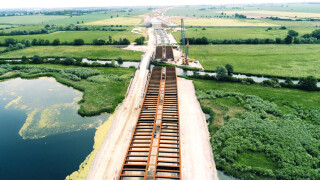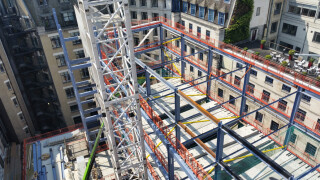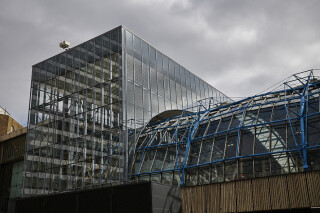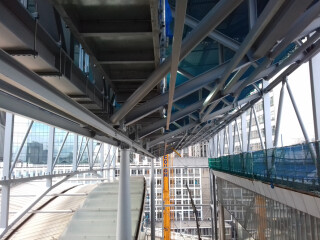This year’s shortlist showcases the engineering nous, ingenuity and imagination of the UK’s construction steel industry. The shortlist also shows how steel is employed throughout the UK and Ireland for an extraordinary range of projects, from attenuating the gale-force winds that beset Leeds’s tallest building to creating a new Dublin landmark in the shape of the Guinness Gravity Bar.
The judges selected the award-winning entries from a shortlist of 22, all of which scored highly in terms of efficiency, cost-effectiveness, sustainability, aesthetics and innovation.
The six projects receiving awards this year were announced on Thursday 1st October and are:
- Tintagel Footbridge, Cornwall
- 52 Lime Sstreet, London
- The Curragh Racecourse Redevelopment, Kildare
- Bath Schools of Art and Design
- A14 Cambridge to Huntingdon Improvement Scheme
- Brunel Building, London.
Below we take a closer look at the award-winning A14 viaduct scheme, plus a couple of the shortlisted projects that didn't make the final cut.
Showpiece viaduct completes A14 upgrade
The River Great Ouse viaduct is the showpiece of the six new bridges that Cleveland Bridge has fabricated and constructed for the new A14 trunk road between Cambridge and Huntingdon.
It is colossal. Stretching for half a mile, the viaduct required 6,000 tonnes of steel, comprising 76 separate main girders and 400 cross-girders. The bridge spans the river itself and a large area of floodplain on either side. Most of the main girders required were 40m long, 2m deep and weighed 50 tonnes apiece.
When it opens to traffic, the viaduct will take the new A14 over the river and the East Coast Mainline Railway. It is part of the new £1.5bn, 19km-long A14 upgrade which was opened to traffic in May, eight months ahead of schedule.
Some 64 pillars carry the viaduct over the River Ouse floodplain, each of them around 2m wide and embedded up to 30m in the ground. The pillars support the 17 spans of steel beams and concrete slabs that form the bridge deck.
The section of bridge that crosses the river has a longer span, posing a significant challenge for the architects and structural engineers. The solution was to specify more complex girders, with larger, deeper haunches to carry the greater load.
This article was first published in the September 2020 issue of The Construction Index magazine. Sign up online.
Cleveland Bridge suggested a different sub-grade of steel for the flanges of these girders, which were in excess of 50mm thick, to avoid the need for layering. This made the haunch girders easier and quicker to fabricate without compromising structural integrity. The girders were re-designed with this change of steel grade in mind, helping to reduce material and fabrication costs. This saved time in the production process, with the added environmental benefit of reducing energy use.
To produce the cross girders more efficiently, Cleveland Bridge devised a new welding procedure. This involved modifying the T- and I-beam machine with two welding heads on each arm, instead of the usual one, allowing twice the amount of weld metal to be placed per metre per minute. This measure improved the efficiency of fabrication significantly.
The haunch girders are 4.2m at the deepest section so they could not be transported vertically and went to site lying on their side. This meant Cleveland Bridge had to devise a method of righting the 93 tonne girders and then lifting them into position once on site. But the company is experienced in this type of challenge having been involved in both the Tyne Bridge and the Sydney Harbour Bridge.
The fabricator designed a bespoke solution, which it called a ‘lifting claw’: a special assembly that clamped around the top flange and, working over a base of protective timber mats, rotated the girder into an upright position as it was lifted.
LSE’s steel exoskeleton
Featuring exposed steelwork, the latest building to be redeveloped by the London School of Economics is architecturally distinguished both in appearance and design. The Central Building Redevelopment (CBR) replaces four buildings yet makes way for a wholly new public square beneath which there is a 200-seater auditorium, a bar and plant rooms.
The site is in central London, where space is at a premium, so the design maximises floor space by slimming down the floor construction and using rectangular hollow section (RHS) or plated floor beams, featuring bottom plates to support the building’s long span precast floor units, which sit within the depth of the beams.
The design’s use of exposed structural steelwork required Billington Structures to engineer bespoke parts and to ensure that most of the steel connections are hidden from view. This was achieved by either using flush connections or positioning the end-plates to create a shadow gap that could then be used as a repeating pattern, so it became an architectural effect. In order to avoid welding on-site, many of the steel members have an internal bolt connection that is concealed behind a hatch.

From ground level, the building consists of two elements: the 13-storey Tower Block and the six-storey Houghton Block. At either end of the blocks, that sit side-by-side for just under half of their lengths, exposed square hollow section (SHS) bracings bookend the project and form another highly visible exposed steelwork element. This exoskeleton bracing, which sits approximately 300mm outside of the building envelope, is an aesthetic element and structural necessity, sharing the stability with two concrete cores. Significant forces are transferred both within and into the SHS bracing system, and so Billington Structures engineered bespoke cruciform node joints with machined flush plates, to ensure the correct standard of finish was achieved.
At ground floor level, encased in concrete, there are two large plate girders measuring 17m long × 1,600mm deep, so big that each one had to be brought to site in two pieces. These are part of the basement construction and so extend beyond the footprint of the building and underneath the public square, to the girders and are designed to carry heavy loads from fire engines in an emergency, and a mobile crane for when the rooftop plant needs to be replaced.
The Tower Building has an atrium formed by exposed steel columns that start at basement level. This atrium provides access to the auditorium and to the Tower’s main staircase, known as the ‘meandering stair’ as it shifts along the structure one bay per floor. The idea of this design is to improve connectivity and collaboration between different departments on different floors.
This staircase is formed with a lightweight prefabricated steel frame and was lifted into position piece by piece along with the main steel frame.
The result is that the LSE have both a new building and a new public square to add to its amenities. The building itself is at the leading edge of academic architecture and, despite making way for a new square, has an internal floor area of 15,507m2 that is only fractionally less than the four buildings it has replaced.
Waterloo’s small wonder
In terms of steel used, the roof at London’s Waterloo Station is one of the smallest to be shortlisted for the BCSA’s 2020 awards – only 400 tonnes and 15% of that was temporary. Yet it required a great deal of complex design work to meet the brief, which involved retaining two specific views.
The roof covers a new concourse filled with shops, bars and restaurants that links the 1990s-built Waterloo International Terminal (WIT) with the original station and fills the gap between the original Victorian-built Waterloo station canopy and the adjacent curved and glazed roof of the WIT structure.
Network Rail wanted the new roof to shelter commuters while preserving two vistas that are integral to the station’s aesthetic appeal: the Grimshaw-designed WIT arches seen when entering the former Eurostar terminal; and the listed Waterloo station Victory Arch and stairs viewed when leaving the same platforms.
The site imposed its own restrictions on the roof construction because of what lies beneath: Waterloo station’s underground ticket hall and a lot of tunnels. This ruled out any form of piling so the structure for the new roof needed to be light. Steel was the natural choice.
The infill roof is a rectangular steel-framed box, tapered along one side to accommodate the shape of the WIT structure and over-sailing the two station roofs. It measures 52m × 18m × 26m high at the western end and 21m high at the eastern end and is supported at either end by a steel-framed and blast-compliant glazed envelope.
Although the eastern gable is supported on Waterloo’s 1840s-built masonry walls the new structure is otherwise self-supporting. It sits within millimetres of both the WIT roof and the adjacent 19th Century-built Waterloo roof, close enough for weather protection but far enough to allow 135mm of movement.
Although the steel is relatively light, the load of 400 tonnes has to borne somewhere and so the team had to calculate whether existing loads could be transferred elsewhere to accommodate the new roof. So, the buffer stops in the WIT were moved 50m down the line to remove any potential train impact from the new roof and free up some load-bearing capacity from the existing structures.
These were then reinforced with two 508mm-diameter circular hollow section (CHS) columns to support it in the middle. These CHS columns allow the structure to have a central area with a 26m clear span yet, because no foundations can be installed, the CHS members are founded directly on top of the WIT platform slab using bearings to preserve the roof.
The main span of the roof, its spine, is a 52m-long spine truss that is 4.2m deep and weighs 27 tonnes. It was brought to site in three sections, with the longest element, which spans between the CHS columns, weighing 13.5 tonnes. This central spine truss supports a series of eight pairs of gullwing trusses that sit perpendicular to the main structure and form overhangs on either side. Each wing measures approximately 8.3m long x 4.0m deep.
This article was first published in the September 2020 issue of The Construction Index magazine. Sign up online.
Got a story? Email news@theconstructionindex.co.uk






